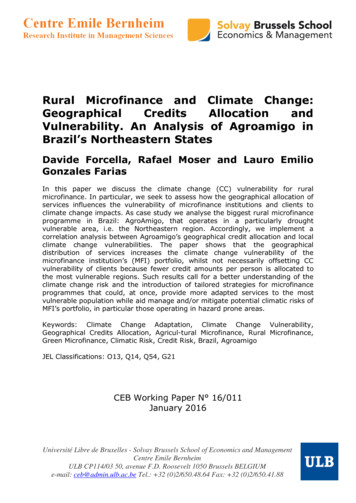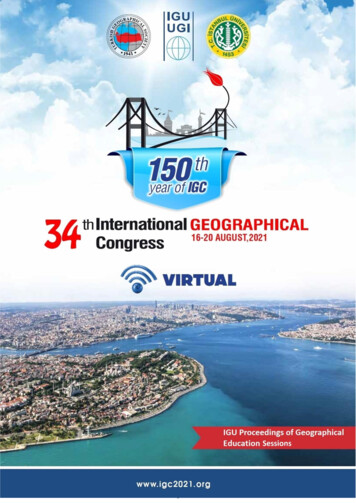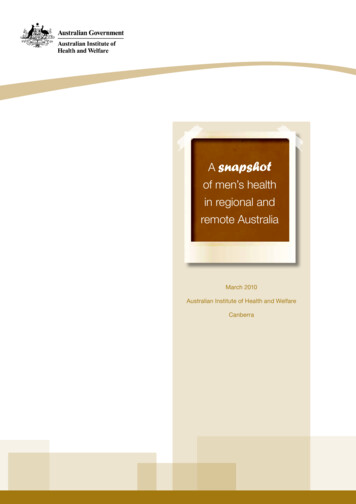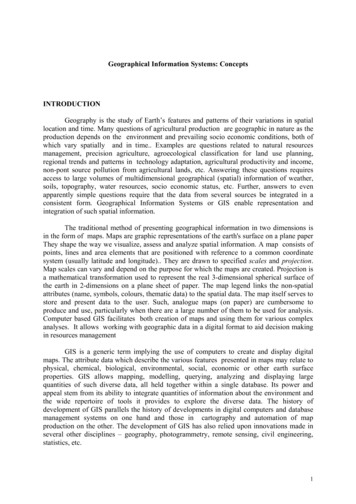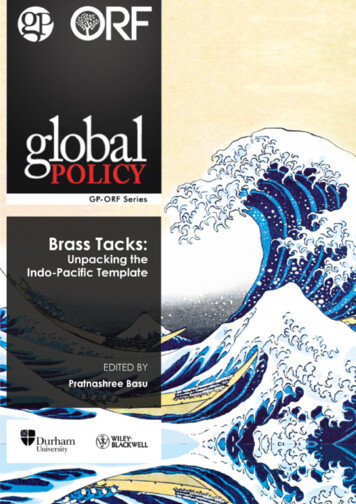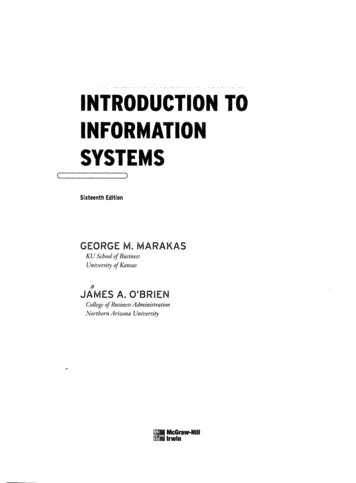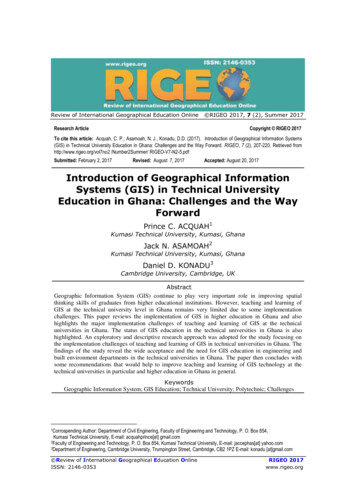
Transcription
Review of International Geographical Education Online RIGEO 2017, 7 (2), Summer 2017Research ArticleCopyright RIGEO 2017To cite this article: Acquah, C. P.; Asamoah, N. J., Konadu, D.D. (2017). Introduction of Geographical Information Systems(GIS) in Technical University Education in Ghana: Challenges and the Way Forward. RIGEO, 7 (2), 207-220. Retrieved fromhttp://www.rigeo.org/vol7no2 /Number2Summer/ RIGEO-V7-N2-5.pdfSubmitted: February 2, 2017Revised: August 7, 2017Accepted: August 20, 2017Introduction of Geographical InformationSystems (GIS) in Technical UniversityEducation in Ghana: Challenges and the WayForwardPrince C. ACQUAH1Kumasi Technical University, Kumasi, GhanaJack N. ASAMOAH2Kumasi Technical University, Kumasi, GhanaDaniel D. KONADU3Cambridge University, Cambridge, UKAbstractGeographic Information System (GIS) continue to play very important role in improving spatialthinking skills of graduates from higher educational institutions. However, teaching and learning ofGIS at the technical university level in Ghana remains very limited due to some implementationchallenges. This paper reviews the implementation of GIS in higher education in Ghana and alsohighlights the major implementation challenges of teaching and learning of GIS at the technicaluniversities in Ghana. The status of GIS education in the technical universities in Ghana is alsohighlighted. An exploratory and descriptive research approach was adopted for the study focusing onthe implementation challenges of teaching and learning of GIS in technical universities in Ghana. Thefindings of the study reveal the wide acceptance and the need for GIS education in engineering andbuilt environment departments in the technical universities in Ghana. The paper then concludes withsome recommendations that would help to improve teaching and learning of GIS technology at thetechnical universities in particular and higher education in Ghana in general.KeywordsGeographic Information System; GIS Education; Technical University; Polytechnic; Challenges1CorrospendingAuthor: Department of Civil Enginering, Faculty of Engineering and Technology, P. O. Box 854,Kumasi Technical University, E-mail: acquahprince[at] gmail.com2Faculty of Engineering and Technology, P. O. Box 854, Kumasi Technical University, E-mail: jaccephas[at] yahoo.com3Department of Engineering, Cambridge University, Trumpington Street, Cambridge, CB2 1PZ E-mail: konadu [at]gmail.com Review of International Geographical Education OnlineISSN: 2146-0353RIGEO 2017www.rigeo.org
Acquah, C. P.; Asamoah, N. J.; Konadu, D. D. (2017) / Introduction of Geographic Information .Geographic Information Systems (GIS) since its introduction into higher education inthe early 1990s (Zhou et al., 1999) has proven to be a very resourceful educational toolfor both educators and students in higher education. Teaching and learning of GIS at thetertiary level provides important technical skills for students who are interested inapplying GIS technology directly as a major application tool in industry and alsoimproves the competence of those who may indirectly utilize GIS approaches indecision-making processes (Whyatt et. al., 2011). GIS has greatly improved spatialdecision-making processes in universities and industries (Baker et al., 2012) by bringingtogether spatial datasets of different referencing systems for effective manipulation andanalysis in a computer environment. Some important justifications for GIS introductionin education have been outlined by Bednarz (2004). Bednarz 2004 described GIS ineducation as an “educative tool that enhances student's spatial thinking skills and also asworkplace skills where GIS is needed as a tool for future knowledge in geospatialtechnologies”. In furtherance to that, geospatial technologies have been used byeducators to enhance classroom teaching and learning environment (McClurg and Buss2007). Currently, schools all over the world are introducing GIS in their curricula tohelp their students gain valuable knowledge and skills with which to face globalchallenges (ESRI 2011). Apart from tertiary institutions, GIS as a teaching and learningtool has been introduced in basic schools in some countries, including the USA(Bednarz, 2004), Canada and a number of European countries (Broda and Baxter 2003;Kerski 2003; Wigglesworth 2003; Bednarz and Van der Schee, 2006). Countries such asFrance, Finland and Sweden have also included GIS in their secondary schoolcurriculum but had some implementation challenges (Johansson and Pellikka, 2006).India, in 2000, also introduced GIS at the secondary school level as part of geographycurricula under the National Framework for School Education project (NCFSE, 2000).GIS was introduced into Ghana's educational system at the tertiary level first in theuniversities and later in the polytechnics now known as technical universities. Althoughthe prospects of GIS education and development in Ghana are high even at thesecondary school level (Oppong and Ofori-Amoah 2012), much has not beenaccomplished by the ministry of education, policy makers and other stake holders tofully integrate it across all levels of education system. Workforce studies suggest thatthe services of surveyors, computer programmers, agricultural technicians and expertsin logistics with spatial database expertise would be sought for in today'stechnologically driven world economy (Estaville, 2010; Rudibaugh and Ferguson,2010). In contrast, the teaching and learning of GIS in Ghana is not widespread even atthe tertiary level. Currently, majority of professionals graduating from higher educationin Ghana lack the needed spatial thinking skills and abilities that could make themcompetitive in today's job market. This notwithstanding, the introduction of GISeducation in Ghana especially at the technical university level has shown to improvegraduates spatial thinking skills and prepare them adequately for the challenges in theirprofessional endeavors. However, there still exist some challenges that have impededthe effective implementation of GIS education at the technical university level. A crosssectional survey was conducted to investigate the implementation challenges in teachingand learning of GIS in the technical universities in Ghana. The need and the acceptancelevel of GIS technology were also assessed. This paper presents the findings of the208
Review of International Geographical Education Online RIGEO Volume 7, Number 2, Summer 2017study and finally concludes with recommendations that would improve the teaching andlearning of GIS technology in the country.The Current State of GIS Education in GhanaGIS was introduced into higher education in Ghana in 1998 as an undergraduatecourse in the department of geomatic engineering, Kwame Nkrumah University ofScience and Technology (KNUST). It was later extended to the graduate level in civilengineering, planning and land economy departments at KNUST. In 2002,Environmental Systems Research Institute (ESRI), the developers of ArcGIS softwareapplication suite, supported the geomatic engineering department of KNUST with agrant to establish a GIS laboratory to assist in teaching, learning and research in theuniversity community and the West African sub-region. The setting up of the GISlaboratory empowered the department to organize short courses and training in GIS forstudents, lecturers, researchers and members of the university community. Currently,besides the geomatic engineering department, GIS is taught as core course in the CivilEngineering department at the graduate level, and at both graduate and undergraduatelevel at departments of geography, geophysics, planning, environmental science, landeconomy, material science engineering and geological engineering all in KNUST.Besides KNUST, GIS is treated as core course at geography, environmental andgeomatic engineering departments in all public universities in Ghana. Other privateinstitutions including central university and catholic also teach GIS as core course.Kumasi, Takoradi, Wa, Koforidua and Sunyani technical universities are the five out ofthe ten technical universities in Ghana that offer GIS as a core course. KumasiTechnical University (former Kumasi polytechnic), was the first technical university tointroduce GIS as a core course in 2008. It was introduced as a modular course in thecivil engineering department at the Higher National Diploma level. In 2010 and 2012, itwas introduced to Bachelor of Technology (first degree) students of civil engineeringand estate management departments respectively. In 2012, ESRI, through its localrepresentative, embarked on a country-wide distribution of ArcGIS educationalpackages as grant to some selected second cycle and tertiary institutions in Ghana withthe aim of making GIS accessible for all. Two of the traditional public universities, oneprivate university college, one technical university and six-second cycle institutionsbenefited from this grant.GIS Application Areas in the Technical UniversitiesGeographic information, in its simplest form, is the knowledge about what is where,when and where. GIS as described by Catlin Dempsey, (2012) is a technological fieldthat incorporates geographical features with tabular data in order to map, analyse, andassess real-world problems. The power of GIS is its ability to integrate both spatial dataand attribute data of features they represent. GIS has been used extensively to supportdecision making in many organisations, government, educational and researchinstitutions over the years. The wider applications and benefits associated with GIShave resulted in it being taught across a much broader range of professional disciplinesin recent times than was previously limited to geography and environmental science(Bearman et. al., 2015). Across the technical universities in Ghana, the main areaswhere GIS is needed as a core course include departments in the faculties of built and209
Acquah, C. P.; Asamoah, N. J.; Konadu, D. D. (2017) / Introduction of Geographic Information .natural environment, engineering, creative arts and technology and in the appliedsciences. In civil engineering for example, GIS is used extensively in highways andtransportation planning, road and traffic management, water and sanitation andenvironmental monitoring. The use of GIS as a database platform for managing andmonitoring transportation infrastructure has proven to be very effective (Miller andShaw, 2015). In electrical and electronic engineering, the use of GIS for automatedroute selection of new power lines, load forecasting and optimization planning forsubstations in power system is known to have significantly enhanced the efficiency inthe power sector (Rezaee et al., 2009).The application of GIS in the oil and gas industries, from the exploration to theproduction, refining and transportation is also phenomenal. GIS is used to collect, store,analyse and display the spatial locations of wells, pipelines and other features in theenvironment for better decision making. In surveying and estate management, GIS hasbeen used in keeping proper inventory of land and property records necessary forproperty valuation and facility management (Dale and McLaren, 1999). GIS is alsoapplied in the building and construction industry for quantities take off and constructionestimates by the building and architectural professionals (Cheng and Yang, 2001;Bansal and Pal, 2007). Moreover, GIS is widely applied in regional and urban planning(Waddell, 2002), as well as municipal administration and management of the naturaland built environment. In tourism and hospitality industry, GIS is used to assist touristin finding nearest hotels and restaurants and also in finding shortest and fastest routes totheir destination of choice (Gill and Bharath, 2013; Chen, 2007). GIS is able to show alarge amount of tourist information in an easy to read indexed map. GIS has also beenused extensively in environmental studies, resources engineering and management,business and management studies (Chinchu and Selvakumar 2012). Thisnotwithstanding, the teaching and learning of GIS is not widespread across the technicaluniversities in Ghana who are noted for the training of highly skilled professionals totake up the supervisory role in the industryMaterials and MethodsAn exploratory research design was adopted for the study, focusing on theteaching and learning of GIS in the technical universities in Ghana. The questionnaireswere structured to include close-ended and rating-scale questions arranged inaccordance with the objectives of the study. Out of one hundred and two (102) selfadministered questionnaires distributed, sixty-one (61) were returned representing59.8% return rate. Purposive sampling method was therefore used in administering thequestionnaires across the ten (10) technical universities in Ghana. Thirty-five (35)lecturers from different academic departments responded to the survey. In addition, ten(10) heads of departments and sixteen (16) technicians also responded to the survey.Descriptive statistics were used to analyze the data collected with the help of StatisticalPackage for Social Sciences (SPSS) and Microsoft Excel applications. The outliers inthe questionnaires, which could potentially affect the results and the subsequentdiscussions were detected and removed. The responses were coded in the SPSS forfurther analysis and the results presented in the form of bar and pie charts. Table 1provides the summary of the teaching staff sampled and their respective faculties.Table 1210
Review of International Geographical Education Online RIGEO Volume 7, Number 2, Summer 2017Distribution of respondentsID FACULTY1Built and Natural Environment2Engineering3Other .93% of the teaching staff came from the faculty of engineering, 26.23% from thebuilt and natural environment and the remaining 9.84% came from mathematics,computer science, agricultural science and industrial arts departments.FindingsGIS Implementation ChallengeThe challenges of GIS in education globally have been found to be both practical andconceptual. The practical challenges have to do with the funding and maintenance of theneeded hardware and software and other infrastructural needs whereas that of theconceptual challenges bother on the reorganisation of the curricula and the adoption ofnew teaching methods (Foote et al., 2012). The introduction of GIS into the technicaluniversity education, the then polytechnics in Ghana in 2008 had to contend with thesechallenges. The conceptual challenge in Ghana can be linked to the lack of policies inthe curriculum development and regulatory standards in spatial data acquisition andsharing.The Availability of GIS FacilitiesThe availability and the level of adequacy of GIS facilities in the technicaluniversities such as laboratory space, software and hardware availability and geospatialdata were surveyed to determine the current state of GIS facilities in the technicaluniversities. Figures 1a, 1b, 1c and 1d graphically show the results of the level ofadequacy of existing GIS facilities in the technical universities.Figure 1a. GIS hardware availabilityFigure 1b. GIS softwareware availability211
Acquah, C. P.; Asamoah, N. J.; Konadu, D. D. (2017) / Introduction of Geographic Information .More than half of the respondents (57.38%) agreed that the level of adequacy of GISsoftware is very low in the technical universities. The results clearly depict the poorstate of GIS facilities in the technical universities and how they contribute to the currentchallenges in the teaching and learning of geospatial technologies in Ghana. About 80%of the respondents collectively agreed that the level of adequacy of GIS hardware iseither low or very low. 52.46% of the respondents also agreed that access to geospatialdata is very low at the universities.Figure 1c. GIS Laboratory availabilityFigure 1d. GIS data availabilityThe practical challenges such as infrastructural challenges, lack of access to digitalspatial data and GIS instructional materials and low level of Information andCommunications Technology (ICT) knowledge and skills among students in thetechnical universities were also surveyed and analysed.Infrastructural ChallengesAcquisition and maintenance of GIS software and hardware packages have beenidentified as some of the major implementation challenges for the technical universities.This is attributed to the poor funding of polytechnic education on the part ofgovernment (Nyarko, 2011). GIS software packages are generally expensive and requireconsiderable investment for initial acquisition and maintenance. However, in Ghana,one major setback in the education system is the lack of financial support to acquiresoftware and programs for teaching and learning purposes.The acquisition of the hardware component of GIS infrastructure is also a majorimpediment in the successful implementation of GIS programmes in the technicaluniversity. A quarter of respondents (25%) strongly agreed and 43.33% agreed that highcost of GIS software is one of the major challenges as indicated in Figure 2. In additionto the high cost of GIS software, GIS software has been designed to run on high speedcomputers with larger storage capacities. These kinds of computers are very expensive,coupled with the need for furnished laboratories with efficient and reliable internetconnectivity involve substantial capital cost.212
Review of International Geographical Education Online RIGEO Volume 7, Number 2, Summer 2017Figure 2. GIS software infrastructureOther hardware components of the GIS setup such as digitizers, scanners and plottersalso require huge sums of money to procure and maintain. 68.33% of respondentscollectively are of the opinion that challenges with the acquisition and maintenance ofhardware has a negative impact on the implementation of GIS education. 30% of therespondents strongly agreed and 36.67% agreed to the fact that lack of laboratory spaceto support teaching and learning in the technical universities is also a challenge.Figure 3. GIS hardware infrastructureIn addition to this, 68.33% of the respondents collectively believe that the poor stateof ICT infrastructure in the country also poses a challenge for the adoption of freesource GIS packages and other internet-based GIS programs like the Google and Yahoomaps.213
Acquah, C. P.; Asamoah, N. J.; Konadu, D. D. (2017) / Introduction of Geographic Information .Figure 4. Access to GIS laboratories in the technical universitiesLack of Access to Digital Geographic DataBesides the infrastructural challenges, 50% of teaching staff collectively agreed thataccess to digital spatial data and instructional materials for teaching and learning is alsoa challenge. Acquisition and transfer of digital spatial data for academic purposes inGhana are extremely difficult and expensive. The digital data and the few hard copymaps available are also not up to date and the facilities and infrastructures such asscanners and digitisers for their conversion into the digital formats are also not readilyavailable. In addition to accuracy and currency of spatial data, many of these data are ofdifferent projections system which brings about compatibility issues. In otherjurisdictions, there are number of organisations and clearinghouses that provide GISdata either for free or at a very low cost for academic purposes. On the contrary, there isno such centralised database in Ghana where students and educators could easilydownload data either for free or at a low cost.Figure 5. Access to GIS data214
Review of International Geographical Education Online RIGEO Volume 7, Number 2, Summer 2017Low Level of ICT Knowledge and Skills of StudentsAnother contributing factor that the researchers considered was the level of ICTknowledge and skills of students in the technical universities. Since GIS is a computerbased application, the basic requirement for effective teaching and learning of GIS is thebasics in computer literacy. Experience has shown that students who exhibit a high levelof computer literacy tends to understand the concept and the application of GIS betterand are able to use the system effectively than their counterparts with low knowledge incomputers.Figure 6. Level of ICT knowledge and skillsDespite government's effort of improving ICT education in Ghana by the enactmentinto law an ICT for Accelerated Development (ICT4AD) policy in 2003 and thesubsequent ICT in education policy in 2008 which was reviewed in 2015 with the goalof creating the building blocks for integrating ICTs into education sector, 43.34% of therespondents believe that ICT knowledge and skills is still low and it is impactingnegatively in the technologically based courses in higher education including theteaching and learning of GIS.Recommendations for ImprovementThe challenges associated with the implementation of GIS in technical universities inGhana discussed points to the need for GIS educators, policy implementers and otherstakeholders to devise comprehensive measures to improve the current situation.Discussed below are some suggested recommendations that would help improve theteaching and learning of GIS in technical universities in particularly and highereducation in Ghana in general.Improvement in GIS Infrastructure in Technical UniversitiesPlacing more emphasis on skills acquisition with the project-based approach toteaching and learning of GIS in the technical universities will require an improvementin the existing GIS infrastructure. These must include a well-furnished GIS laboratoriesin the technical universities with high speed computers and other accessories such215
Acquah, C. P.; Asamoah, N. J.; Konadu, D. D. (2017) / Introduction of Geographic Information .scanners, plotters and digitisers. Improvement of the weak ICT infrastructure in Ghanawill also go a long way to improve teaching and learning of GIS in school throughadoption of e-learning, spatial data sharing and transfer. It will also promote theadoption of short courses on the internet to augment classroom lessons.Teaching and Learning ApproachThe conventional approach to teaching and learning in schools and colleges in Ghanaand in many developing countries has not been student centred. There is moreconcentration on educators imparting knowledge to students with little or no emphasison the acquisition and demonstration of skills by students in the learning process.Researchers, Favier and Van de Schee, 2007 and Bednarz, 2004 have all emphasised theimportance and the need to combine knowledge and skills acquisition in geographyeducation. Favier and Van de Schee, 2012 also explored and outlined the characteristicsof design principles for GIS supported inquiry-based geography education. As noted bySchultz (2012), active learning, when put together with inquiry based and problembased learning system creates a mechanism by which GIS technology can be practicedto a point of fluency. The best approach to teaching and learning GIS in the technicaluniversities therefore is the project-oriented approach. This, therefore, will require morehands-on training with the software by allowing students to be actively involved in thelearning process.Collaboration with Universities and Other InstitutionsA distinctive feature of GIS education is the way educators have workedcollaboratively often across disciplines and national boundaries to innovate and improvepractice (DiBiase et al, 2012). An effective collaboration with established institutionssuch as public universities in Ghana that have built reputation in GIS education over theyears will help to address some infrastructural challenges in the institutions.Additionally, the technical universities have to establish links with GIS softwaresuppliers, consultants and a wide range of users. If such collaborations are already inplace, it could be further enhanced in the pursuit of better and efficient GIS education inother technical universities. At the initial stage of GIS implementation and the efforts bythe technical universities to confront the infrastructural challenges, the technicaluniversities can establish relationship with the geography and geomatic engineeringdepartments in the public universities with the requisite experience and expertise.Restructuring of Geography and ICT Education in GhanaRestructuring of ICT education in schools and colleges especially at the second cyclelevel will help to improve GIS education in Ghana. Experience has shown that, animprovement in ICT training at the secondary school level will produce students withhigh literacy rate in ICT who can easily appreciate GIS technologies. These studentsend up in the technical universities and in other tertiary institutions in Ghana. Over theyears, government has introduced many ICT policies in education and interventionsincluding the recent ICT for education policy 2015 focusing on the use of ICT aslearning and operating tool and also as a career option for students. These efforts mustbe strengthened in order to improve ICT education in Ghana. In addition to this,introduction of GIS into the second cycle education as part of geography curriculum assuggested by Oppong and Ofori-Amoah (2012) will also give students entering the216
Review of International Geographical Education Online RIGEO Volume 7, Number 2, Summer 2017higher educational institution in Ghana a brief introduction of GIS and will preparethem adequately for higher education and training in GIS.ConclusionsGIS has proven to be a very useful professional tool since its introduction intotechnical university education in Ghana. This notwithstanding, there are significantimplementation challenges that have been outlined in this paper that require urgentattention in order to realise the full potentials of GIS education at the technicaluniversity level in Ghana. Addressing these challenges would require collaborativeefforts of GIS educators, government and other stakeholders in the GIS industry. Inspite of the implementation challenges discussed in this paper, the prospects of GIS inGhana remain high. There is an increasing awareness of GIS application in variousprofessional disciplines, which suggest that an adequately trained workforce willcontinue to be in high demand. Thus, it is imperative that GIS educators and otherstakeholders in the industry work consciously to improve the current infrastructure andhuman resource in order to realize the full potentials of GIS at the technical universitieslevel in particular and in Ghana as a whole.ReferencesBaker T. R., Kerski J.J., Huynh N. T., Viehrig K., & Bednarz S. W. (2012). Call for an Agendaand Center for GIS Education Research, Review of International Geographical EducationOnline (RIGEO), 2, (3), 254-288.Bansal, V. K., & Pal, M. (2007). “Potential of Geographic Information Systems in building costestimation and visualisation.” Automation in Construction, 16 (3), 311–322.Bearman, N., Munday, P., & McAvoy, D. (2015). Teaching GIS outside of geography: A casestudy in the School of International Development, University of East Anglia. Journal ofGeography in Higher Education, 39 (2), 237-244.Bednarz, S. W., & Van der Schee, J. (2006). Europe and the United States: The implementationof geographic information systems in secondary education in two contexts. Technology,Pedagogy and Education, 15 (2), 191–205.Bednarz, S. W. (2004). Geographic information systems: A tool to support geography andenvironmental education? GeoJournal, 60, 191–199.Broda, H., & Baxter, R. (2003). Using GIS and GPS technology as an instructional tool. TheSocial Studies, 94 (4), 158–160.Dempsey, C. (2012). What is GIS, https://www.gislounge.com/what-is-gis/ [Accessed 18thMarch 2016].Chen, R. J. (2007). Geographic information systems (GIS) applications in retail tourism andteaching curriculum. Journal of Retailing and Consumer Services, 14 (4), 289-295.Cheng, M. Y., & Yang, C. Y. (2001). “GIS-Based cost estimate integrated with material layoutplanning.” Journal of Construction Engineering and Management, 127 (4), 291-299.Chinchu K.S., & Selvakumar G. (2012). Web Service Based E-Logistics Application.International Journal of Modern Engineering Research (IJMER) 2 (2): 084-088.Dale P.F, & McLaren R.A (1999). GIS in land administration. Geographic Information Systems,(2), 859 – 875.217
Acquah, C. P.; Asamoah, N. J.; Konadu, D. D. (2017) / Introduction of Geographic Information .Dibiase, D., Foote, K. E., Tate, N. J. and Unwin, D. J. (2011) Ways Forward for GIS&TEducation, in D. J. Unwin, K. E. Foote, N. J. Tate and D. DiBiase (eds), TeachingGeographic Information Science and Technology in Higher Education, 451-467, JohnWiley & Sons, Ltd, Chichester, UK. doi: s/higher-education.pdf .RetrivedfromEstaville, L. E. (2010). Geospatial workforce trends in theUnited States. International Journalof Applied Geospatial Research, 1 (1): 57–66.Favier T. T, & Van der Schee, J. (2012). Exploring the characteristics of an optimal design forinquiry-based geography education with Geographic Ingormation System, Computers andEducation, 58 (1), 666-677.Favier, T., & Van der Schee, J. (2007). Learning to think geographically with GIS. FutureProspects in Geography, 395-404.Gill, N., & Bharath, B. D. (2013). Identification of optimum path for tourist places using GISbased network analysis: a case study of New Delhi. International Journal ofAdvancement in Remote Sensing, GIS and Geography, 1 (2), 34-38.Johansson, T. & Pellikka, P. (2006). Geographical information systems applications forschools. 9th AGILE International Conference on Geographic Information Science.Shaping the future of Geographic Information Science in Europe, Visegrád, Hungary,April, 2006.Kerski, J. J. (2003). The implementati
Feb 02, 2017 · Konadu, D. D. (2017) / Introduction of Geographic Information . 208 Geographic Information Systems (GIS) since its introduction into higher education in the early 1990s (Zhou et al., 1999) has proven to be a very resourceful educational tool for both educators and students

